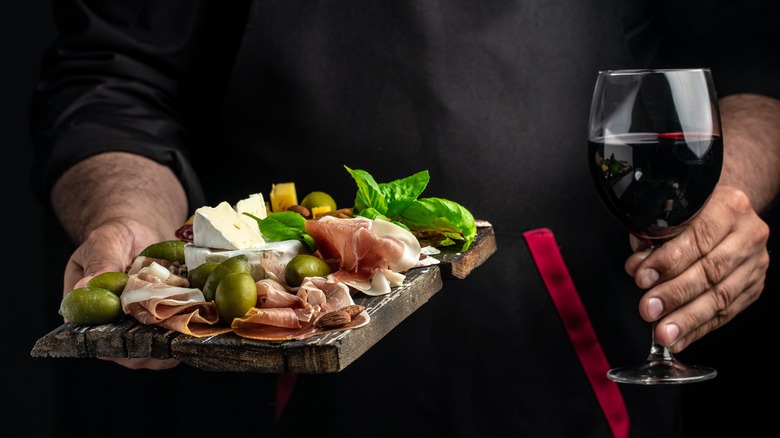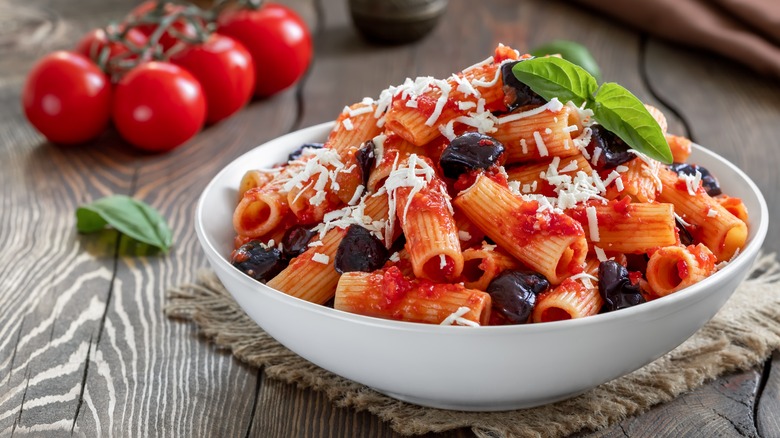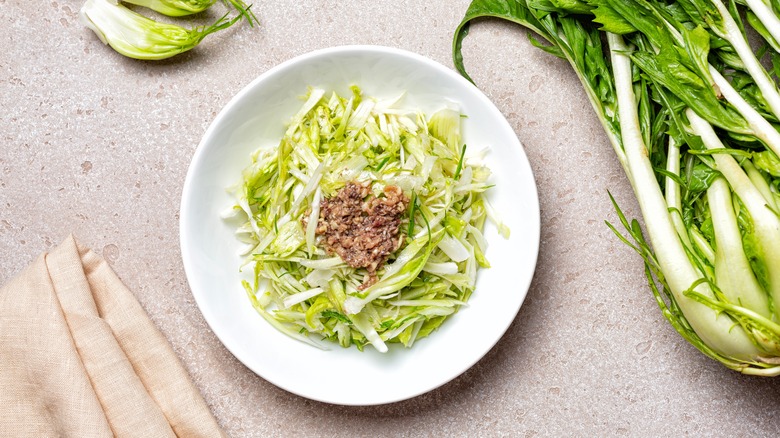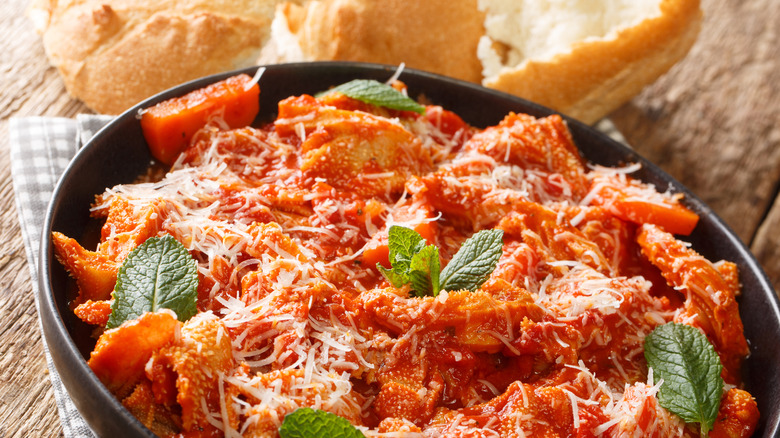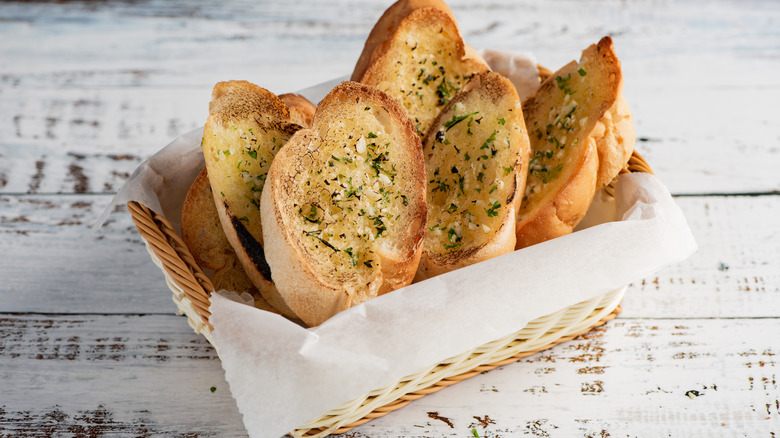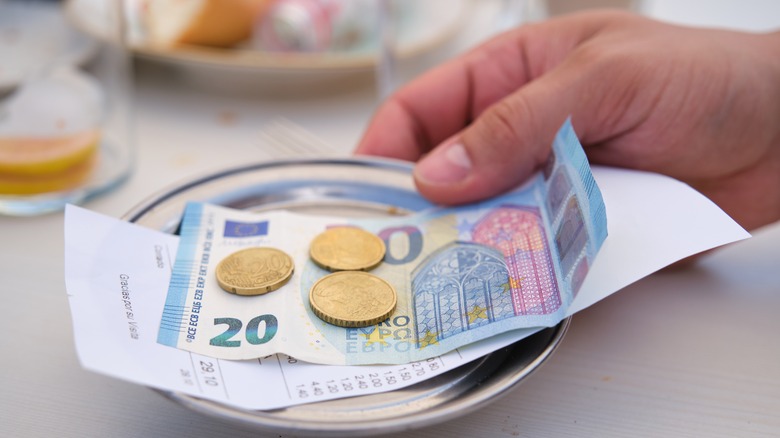All You Need To Read And Order Off Of An Italian Menu Like A Pro
If you're sick and tired of contemporary restaurant servers asking if you "know how the menu works," we feel you. But in Italy, you might truly need a bit of extra help. Unlike in the U.S. — and, indeed, in Italian-American restaurants — there are a few things to note when dining in a restaurant in Italy, whether it's navigating unfamiliar proteins (including but not limited to liver and tripe) or simply ensuring you're not ordering too much, or not enough, food.
"Native Anglophones might encounter false friends on an Italian menu," explains Lenny DiMaria, executive chef of Patricia's of Holmdel, "where words may resemble English words but actually represent different dishes or ingredients." He gives the example of bistecca, which means steak, in Italian, not biscuit; another might be peperoni, which means peppers, not spicy cured meat. And this is just the beginning.
Luckily, we've got you covered. Here is an expert's guide to ensuring you can read and order off an Italian menu like a pro.
Understand the difference between aperitivo and antipasti
The first step of navigating an Italian menu is understanding all of the headings — and there are far more than just appetizer, main, and dessert. In Italy, the first "course" you might see will be aperitivo, a word that doesn't have a great translation in English. Aperitivo is a tradition of pre-dinner drinks and snacks that is usually enjoyed at a bar rather than at a restaurant, and often, at such establishments, the (copious) snacks will be free. Aperitivo often begins around 7 p.m. and, depending on the region, may see spritz paired with cicchetti (tapas) in Venice or local white wine associated with mini pizzas or taralli, a sort of savory biscuit made with lard, wheat flour, and almonds, in Naples. On a restaurant menu, aperitivi may include things like bruschetta or olives and tagliere, which we'd usually call a charcuterie board in English.
Antipasti, meanwhile, are the true answer to appetizers, and most of the time, this will be the first course you're likely to order in a restaurant. Antipasti can be cold, like melon and prosciutto, or hot, like Roman carciofi alla romana, Roman-style artichokes.
Distinguish between primi and secondi (and decide if you need both)
After the antipasto course, you'll find two other menu headings: primi and secondi. If you have a bit of Italian rattling around in your brain, you'll know that these mean "first" and "second,"... but hang on a second, wasn't the antipasto first?
It's not the wine talking: This confusion is normal. Indeed, in a traditional Italian dinner, you may begin with an antipasto and then have a subsequent first and second main course. The primo is usually a starch — pasta, risotto, or polenta, depending on the region — while the second is often meat or fish. Occasionally, you'll find primi and secondi that are actually two pieces of the same recipe, as with a ragù napoletano, a hearty tomato-and-meat stew that sees the sauce served over pasta as a primo and the meat served separately as a secondo.
This might seem like a lot of food, but not to worry if you're not sure your appetite will hold up. "The portion sizes are designed to have two courses, not one large course," explains Amy Brandwein, chef, and owner of Centrolina in Washington, DC. And according to DiMaria, "Italians love to eat, so it is not uncommon to order both, however, it is more common to have just the antipasto and the primi or secondi."
Choose your contorni
If you opt for a secondo, you may find the plate looks bare. And that's by design. "Most Italian dishes do not come with a side," says DiMaria, "so it is up to you to decide what side you would like to accompany your main dish."
Depending on the restaurant — and, again, on the region — contorni are likely to feature vegetables. In Rome, you may be offered cicoria alla romana, aka sautéed bitter chicory with anchovy sauce. In Calabria, meanwhile, pipi e patati, peppers and potatoes, are a common offering. Unlike in the U.S., you are unlikely to find pasta as a side, considering you would have already eaten this starchy course as your primi.
Bear in mind, nevertheless, that while serving separate sides is common, in Italy, it's by no means a rule across the board. "It depends on the type of restaurant," says Brandwein. "In fine dining or more upscale restaurants, each dish is composed as a whole."
Don't ask for substitutions
Given that mains and sides are separate by design, there's less likelihood you'll be tempted to ask for substitutions than if you were in the U.S. But should you be struck by such temptation...resist. According to DiMaria, asking for substitutions or changes to menu items in an Italian restaurant "is seen as unmannerly."
"Unless you have an allergy, it is discouraged to ask to alter your meal," he says, "because most traditional dishes have specific ingredients that cannot be paired with a substitution."
Indeed, according to Brandwein, "it is unusual to ask for a substitution."
"I was just discussing this yesterday," she recounts, "and I think the U.S. started the substitution culture by fast food dining, have it your way, etc. There is less respect for proper dining and boundaries in the U.S."
If you have an allergy or dietary requirement, by all means, let your server know, but bear in mind that rather than change an on-menu dish, you're more likely to be steered towards a different menu item that you can eat as-is.
Learn the words for offal
Italians have a rich culture of preparing organ meats, from Roman-style tripe with tomatoes, pancetta, and mint to Venetian-style calves' liver with onions, wine, and butter. "Many traditional Italian dishes include offal, and some restaurants include offal as a specialty," says DiMaria.
While these dishes are indeed delicious, they may be off-putting to a diner who wasn't expecting them, and seeing dishes will often be peppered on the menu without any particular indication, it's easy to think you're ordering "agnello" (lamb) only to find you missed the word "rognoncini" (kidneys). Familiarize yourself with the words for organ meats so that you can enjoy or avoid them, as the case may be, and be particularly aware if you're journeying to Rome, Tuscany, Umbria, or Sicily, where, according to Brandwein, these dishes are far more common. And when in doubt, Google Translate is a great tool to double check you've understood each and every word in the dish's name.
Choose your coffee wisely
Dessert is fairly self-explanatory, but should you decide to finish the meal with coffee, you may encounter yet another stumbling block linked to translation woes. Indeed, the word caffè doesn't typically refer to all coffee in Italy but rather to espresso specifically.
Things only get thornier from there. Latte is the Italian word for milk, so if you order a latte, don't be surprised if you're brought a cold, white glass of the stuff. If you want a coffee with milk, you should order a cappuccino or a caffè latte. That said, come dinnertime, none of these words should be in your vocabulary: Milky coffee is traditionally only served in the morning in Italy. Ordering coffee with milk after dinner will likely raise eyebrows, so if you want to stay true to tradition, stick to an espresso or an americano, which will be an espresso diluted with a bit of hot water. In a pinch, you could also ask instead for a macchiato, which doesn't refer to anything spiked with caramel sauce. Instead, a macchiato is an espresso "stained" with a touch of milk foam.
Shell out for water, bread, and cutlery
There are a few bits of a meal that most Americans are used to getting for free: a bread basket, for instance, or tap water. In Italy, tap water is rarely offered; instead, you'll be asked if you want still (naturale) or sparkling (frizzante) mineral water, according to Brandwein, and you will need to pay for it.
The same is true for bread, your silverware, and even the tablecloth. This may seem odd, but these are indeed added costs to the restaurant, and these elements of the meal are thus usually included as a line item on your bill called the coperto. (And before you ask, you can't opt out of a napkin to avoid this surcharge, which usually hovers around two to three euro).
Remember that while the bread is included in the coperto in some restaurants, this is not true everywhere. If you're not sure you want or need bread, be sure to let your server know so that you don't end up paying for something you didn't want.
And a word on tipping
Americans tend to tip excessively in Europe, given the way that servers are paid in the U.S. Tipping in America does indeed constitute a majority of a server's wage, so it makes sense, however backward it may seem, that tips constitute 20, 25, or sometimes even 30% of the bill. In Italy, however, this is not the case. According to Brandwein, Italian bills include a service charge, and seeing as Italian servers are indeed paid a living wage, you shouldn't feel the need to tip as you would in the U.S. — or even at all.
That said, according to DiMaria, while tipping is far from required, "it is very much a courteous gesture to your server." Five to 10% is sufficient to show your server you've had a pleasant meal and to thank them for their patience and hard work — not to mention any assistance they may have provided in navigating the menu.

